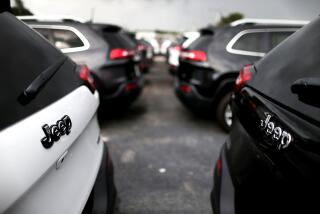Chevy Spark only subcompact car to pass insurance group crash test

Crash tests of small cars.
Of the 11 economy cars crash-tested by the leading insurance industry group, 10 failed a new safety standard for front-end collisions.
Only the Chevrolet Spark earned an “acceptable” grade on the test, in which 25% of the front end, on the driver’s side, strikes a 5-foot-tall barrier at 40 mph.
The Honda Fit, Fiat 500, Hyundai Accent, Nissan Versa, Toyota Prius C and Mitsubishi Mirage all received “poor” grades, according to the Insurance Institute for Highway Safety. The Mazda 2, Kia Rio, Toyota Yaris and Ford Fiesta earned “marginal” scores.
None of these subcompacts earned a “good” mark.
[Updated, 12:57 p.m. PST Jan. 22: After seeing the results Wednesday, Consumer Reports removed the Honda Fit from its list of recommended vehicles. However, a Honda representative noted that the model was being phased out and would be replaced by a newly designed Fit this spring.]
The vehicles were the worst-performing group of any evaluated so far by the institute, which spends about $3 million a year crashing cars and evaluating the results for the insurance industry. The tests are important because they play into safety ratings, car reviews and consumer perceptions, said Karl Brauer, an analyst with auto information company Kelley Blue Book.
Consumer Reports, for instance, dumped some its favorite vehicles — including Toyota’s Camry, RAV4 and Prius V — from its list of recommended cars last year because the vehicles scored poorly in the test. The influential magazine put the Camry back on its recommended list in December after Toyota modified the car’s structure to earn an “acceptable” rating.
“Crash tests are one of those things that a dedicated minority of buyers look at,” Brauer said. “They won’t even consider a car unless they are sure the crash-test scores are good.”
Toyota has typically scored poorer than companies such as Honda and Volvo in the tests, Brauer said.
“We are looking at a range of solutions to achieve greater crash performance in this area,” Toyota spokesman Michael Kroll said. “This is a more-stringent test, and we will adapt. In fact, we moved very quickly with Camry to make changes that resulted in an improved score.”
The insurance group established the “small overlap front crash test” because front-corner collisions can be particularly severe.
The institute said the test is more difficult than the head-on crashes conducted by the government, or even other assessments by the institute, because most of the vehicle’s front-end crush zone is bypassed and the passenger compartment can collapse, the group said.
“Small, lightweight vehicles have an inherent safety disadvantage. That’s why it’s even more important to choose one with the best occupant protection,” says Joe Nolan, the institute’s senior vice president for vehicle research. “Unfortunately, as a group, minicars aren’t performing as well as other vehicle categories in the small overlap crash.”
The results were mostly good news for Chevrolet. The Spark’s acceptable rating in the test — along with good ratings in the group’s four other crashworthiness evaluations — earned it a Top Safety Pick award, the institute’s second-highest rating.
But the institute still warned that the Spark’s vehicle structure came apart in the crash.
“When a vehicle’s structure doesn’t hold up, injury risk is high,” the institute said in its report. “Consumers should remember that the Spark, while offering more small overlap protection than other minicars, weighs less than 2,500 pounds and doesn’t protect as well as a larger and heavier vehicle with a comparable rating.”
The crash-test results can’t be compared across weight classes of vehicles.
The tests revealed all sorts of dangers in the subcompacts.
In seven of the cars, either the safety belt didn’t do a good-enough job holding the dummy in place, or the dummy’s head missed or slid off the front air bag. The side curtain air bag didn’t protect the dummy in eight of the cars and didn’t deploy at all in the Toyota Yaris.
The two worst performers were the Honda Fit and the Fiat 500. The dummy’s head in the Fit crash slid by an air bag and hit the instrument panel. The driver door opened after the hinges tore in the Fiat 500 test.
The Fit — to be replaced by a redesigned model this spring — is an exception for Honda, which typically scores high in these tests. Honda’s small Civic sedan, for example, was the only compact car to earn the top rating when that vehicle segment was crash-tested.
Honda expects the new Fit will earn the top rating in the institute’s crash tests, spokesman Chris Martin said.
The automaker is using more high-strength steel in the new model and has redesigned its front structure to better capture and direct the crash energy to improve passenger protection, Martin said.
The institute regularly tests cars and issues ratings as part of its research into automobile safety for the insurance industry. The tests have pushed automakers to make improvements in their cars to win better ratings.
The trade group first started publishing data on these kinds of crashes in 2009 and incorporated it into its ratings in 2012. It has previously tested mid-size luxury cars, mid-size cars and small SUVs.
jerry.hirsch@latimes.com
On Twitter: @latimesjerry
ALSO:
Next big auto battle is aluminum vs. steel
Editors picks of the Detroit Auto Show, (and a miss!)
Ford gambles with aluminum in F-150 pickup truck redesign
Follow me on Twitter (@LATimesJerry), Facebook and Google+.







